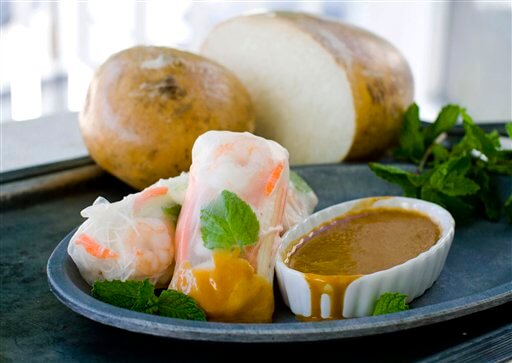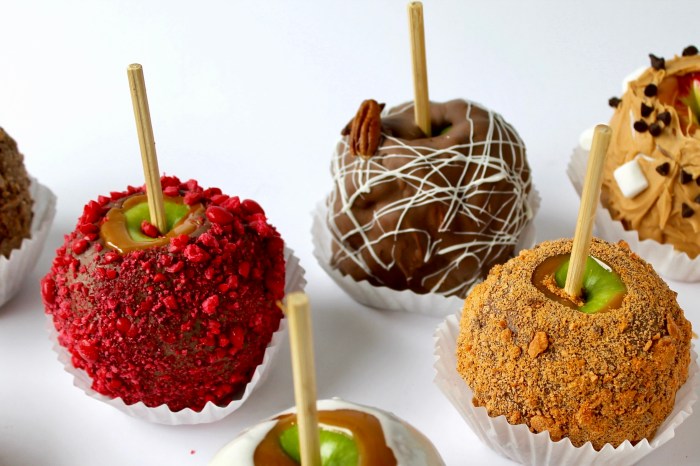
Imagine crossing a monster potato with a water chestnut.
That’s jicama for you. And while not much to look at on the outside, the crisp, crunchy texture and clean, sweet flavor inside makes this veggie worth seeking out.
First, the basics. Jicama (pronounced HICK-a-MUH) is a tuber — a big, brown, round root. A relative of the bean family, it is native to Mexico and South America.
Though most often eaten raw, such as chopped into salads, jicama can be steamed, boiled, sauteed or fried. And so long as you don’t overcook it, jicama retains its pleasantly crisp texture (think fresh apple) when cooked.
The flavor is on the neutral side, with a hint of starchy sweetness. It really is quite similar to water chestnuts, and can be substituted for them.
The roots — which are available year-round — can range anywhere from 8 ounces to 6 pounds. That’s a whole mess of tuber for you.
Once limited mostly to Latin American markets, the popularity of Hispanic foods has pushed jicama into mainstream grocers. The jicama at most grocery stores will be coated in a thick wax. It’s just as well; the thin brown skin isn’t edible and needs to be peeled off anyway.
The easiest way to peel jicama is with a paring knife. Just hack away the skin in chunks, exposing the moist white heart of the root. This then can be cut into chunks, matchsticks or diced.
Whole jicama can be stored at room temperature for a week or so, or refrigerated a bit longer. Once cut, they can be wrapped in plastic and refrigerated for about a week.
For ideas for using jicama, check out the Off the Beaten Aisle column over on Food Network: http://bit.ly/Io3VNT
___
Shrimp and Jicama Spring Rolls
When soaking the wrappers, be sure to do them one at a time. And don’t soak them longer than suggested or they will fall apart. The rice noodles and wrappers can be found in the Asian or International aisle of most grocers.
Start to finish: 30 minutes
Makes 12 rolls
For the dipping sauce:
1/4 cup peanut butter
1/4 cup apricot jam
2 tablespoons soy sauce
2 tablespoons rice or cider vinegar
Hot sauce, to taste
For the spring rolls:
2 ounces dried bean or rice thread noodles
1/2 cucumber, peeled and halved lengthwise
4-ounces peeled jicama root
12 large rice-paper wrappers (8-inch round or larger)
1/2 cup shredded carrots
1 pound cooked and cooled extra-large shrimp, shelled and deveined
12 large fresh mint leaves
To make the dipping sauce, in a blender combine the peanut butter, jam, soy sauce and vinegar. Blend until smooth. Add hot sauce, to taste, then set aside.
Place the noodles in a bowl and cover with hot water. Soak for 5 minutes, or until softened. Drain well in a mesh strainer and set aside.
Use a spoon to scrape out and discard the seeds from the cucumber halves. Cut each piece into thin strips. Cut the jicama into thin slices, then cut each slice into thin matchsticks.
Fill a large bowl (at least several inches larger than the rice wrappers) with warm water. Soak 1 wrapper in the water until soft and pliable, 20 to 30 seconds.
Carefully remove the rice wrapper from the water and lay flat on the counter. Place a small bundle of noodles along one edge of the wrapper. Top the noodles with a bit each of cucumber, jicama and carrots. Place 3 shrimp over the vegetables, then top with a mint leaf.
Roll the wrapper, starting with the filling side, folding the ends over the filling as you roll to form a tight cylinder. Repeat with the remaining wrappers and fillings. Serve the spring rolls with the dipping sauce.
Nutrition information per roll (values are rounded to the nearest whole number): 150 calories; 30 calories from fat (20 percent of total calories); 3.5 g fat (0.5 g saturated; 0 g trans fats); 55 mg cholesterol; 18 g carbohydrate; 11 g protein; 1 g fiber; 320 mg sodium.
___
J.M. Hirsch is the national food editor for The Associated Press. He is author of the recent cookbook, “High Flavor, Low Labor: Reinventing Weeknight Cooking.” His Off the Beaten Aisle column also appears at FoodNetwork.com.


































